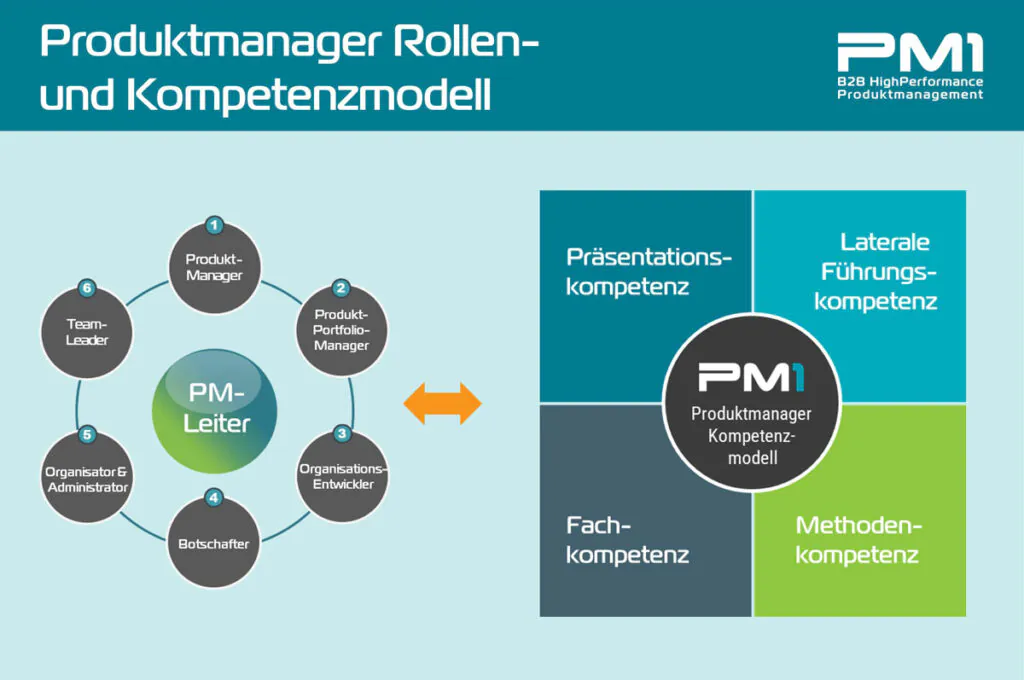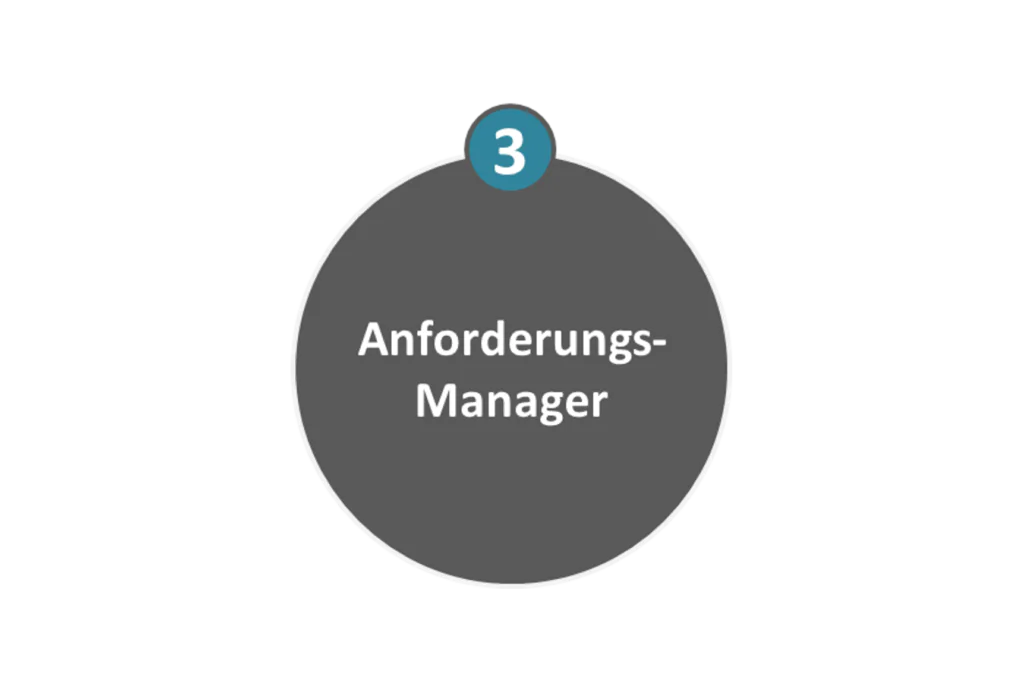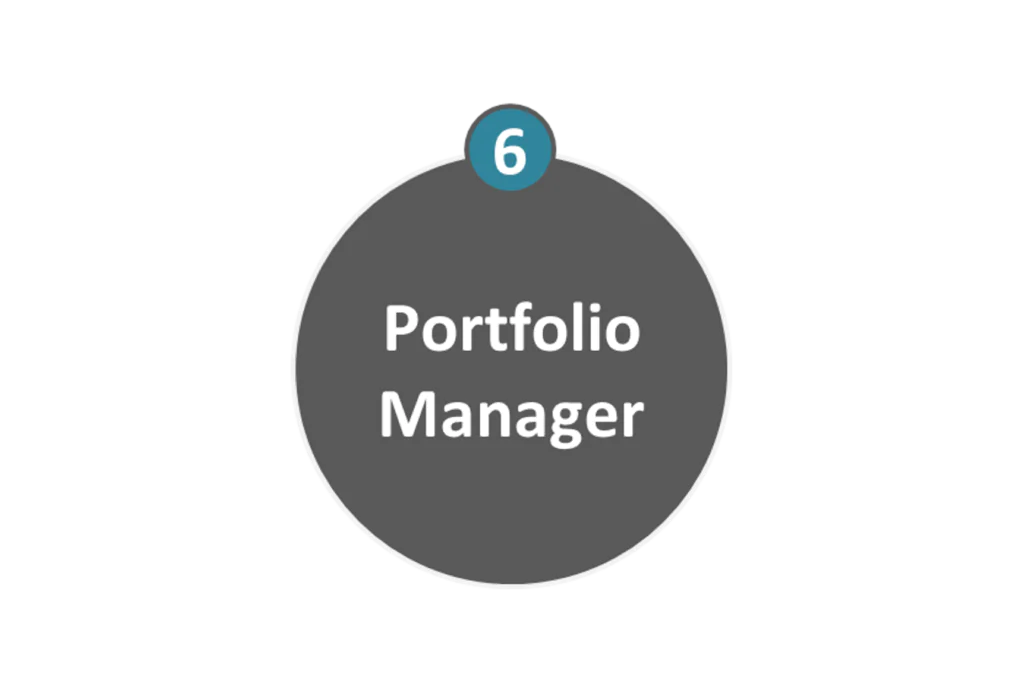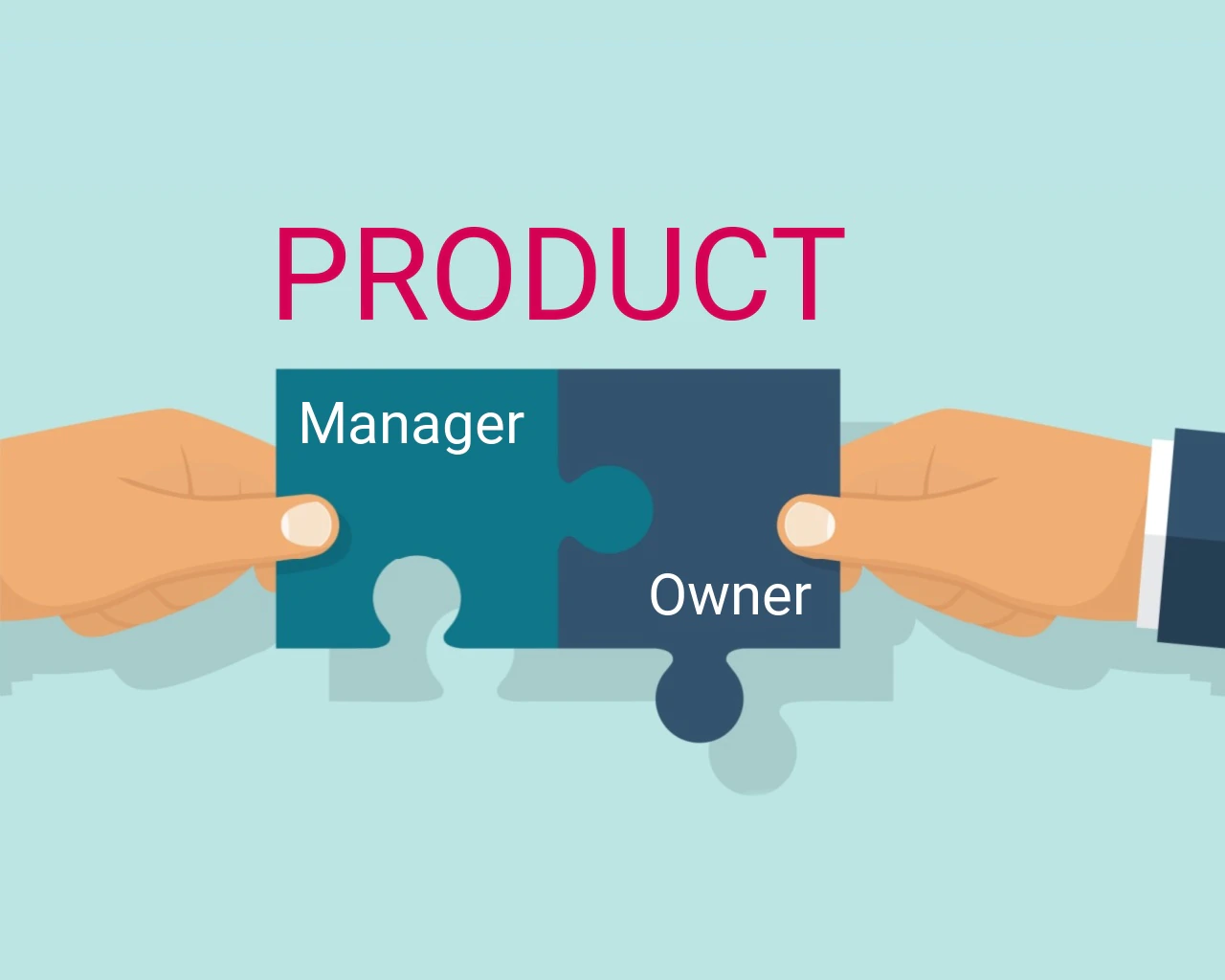Knowledge for product managers
|Product manager tasks
The PM1 product manager role and competence model

The product manager role model is based on the manifesto that the product manager is the entrepreneur for the product. Five interconnected roles can be derived from this, which the product manager has to fulfil: product market expert, strategist, requirements manager, interface manager and promoter. In order to fulfil the associated tasks, they must have a total of four areas of expertise: Professional competence, methodological competence, presentation competence and lateral leadership competence. The importance of the areas of expertise varies depending on the role.
Job description part 1:
The responsibilities of a product manager
The product manager is the entrepreneur for the products or product market entrusted to him. This includes:
- Responsibility for sales and earnings over the entire product life cycle
- Responsibility for strategic orientation and target setting
- Continuous market observation and evaluation of market opportunities
- Consistent alignment with market and customer requirements
- Ensuring competitiveness and future security
- Defining, evaluating and marketing products
- Timely and systematic discontinuation of products
- Aligning the organisational units involved in the provision of services
Job description part 2:
The tasks of a product manager
Product manager as product market expert
Product manager as product market expert

As a product market expert, the PM knows the relevant product market like the back of his hand. This role is his raison d’être. Only a genuine understanding of the market serves as the basis for all subsequent narrow decisions.
- Continuous market observation
- Market research
- Desk research
- Customer visits
- Product usage observations
- Customer interviews
- Customer surveys
- Competition analyses
- Participation in trade fairs & congresses
- Surveys of sales people
- Sales surveys
Product manager as strategist
Product manager as strategist

As a strategist, the PM evaluates market opportunities and shows whether and how these can be utilised profitably for the company. The main instrument here is the product business plan. Planning also includes continuous control. This means that the PM retains overall responsibility as a life cycle manager even after the market launch.
- Interpretation of the market analysis
- Defining goals and strategies
- Reflecting with stakeholders
- Organising strategy meetings
- Creating a product business plan
- Presentation to the product committee
- Obtaining approvals & resources
- Monitoring the implementation
- Adaptation of the strategy
- Manage product life cycle
Product manager as requirements manager
Product manager as requirements manager

As a requirements manager, the PM translates the customer’s problem into specific product and service requirements in the ‘upstream process’. Working out the customer benefit is of particular importance here. In this role, the PM determines ‘what is done’ and the specialist department ‘how it is done’. In the innovation process, the main interface is R&D.
- Collecting ideas and requirements
- Consolidate the requirements
- Evaluate & prioritise requirements
- Working out the customer benefit
- Create specifications
- Negotiate requirements with R&D
- Define target costs and sales volumes
- Track realisation of requirements
- Evaluate prototypes
- Carrying out market tests
- Product master data documentation
- Issue market release
Product manager as interface manager
Product manager as interface manager

As an interface manager, the PM coordinates all specialist departments in order to implement the strategies and measures defined in the product business plan. As the PM generally has no line management authority, he must lead laterally. This requires a high level of communication skills and social competence.
- Organising kick-off meetings
- Moderating meetings
- Negotiating
- Identify and manage stakeholders
- Obtaining commitment and buy-in
- Communicating interim results
- Track implementation measures
- Coordinate activities
- Adjust time and project plans
- Identify critical issues
- Escalate critical issues
- Resolve (resource) conflicts
Product manager as promoter
Product manager as promoter

Now the product is properly marketed to the market in the ‘downstream process’. Marketing communication and sales are the main interfaces here. Central elements in this role are the product launch and marketing campaigns. The PM is in the sales role vis-à-vis their own sales team! Enthusiasm, good presentation skills and the formulation of good benefit arguments are important success factors.
- Planning and preparation of product launch
- Realisation and project management of product launch
- Creation of product presentations
- Selling the product to sales
- Realisation of product presentation
- Realisation of sales training courses
- Roadshows and customer visits
- Selective sales support
- Obtaining feedback from the distribution channel
- Adaptation / sharpening of sales arguments
- Identify and activate multipliers in the channel
Product manager as portfolio manager
Product manager as portfolio manager

If the product manager is responsible for not just one product, but an entire portfolio of products, their role as strategist expands to that of portfolio manager. The aim here is to further develop the existing portfolio towards a successful target portfolio through the targeted management of phase-in and phase-out.
- Regular analysis of existing product portfolio
- Idea evaluation and management
- Competitive portfolio analyses
- Definition of target product portfolios
- Portfolio roadmap development
- Project pipeline prioritisation
- Portfolio phase-out management
- Product portfolio yield management
Job description part 3:
The competences of the product manager
The product manager is the entrepreneur for the products or product market entrusted to them. To be successful in this role, the product manager needs a wide range of competences that go beyond simply understanding the product. Key skills include not only basic technical and methodological expertise, but also the ability to coordinate resources effectively – with the communication skills to interact with different teams and stakeholders. The PM1 competency model summarises the required competencies. The job description of a product manager should reflect these competency requirements.
Professional competence
The product manager needs extensive knowledge and understanding of the entire relevant product market. This includes:
- Function, structure and application of our own products
- Underlying technologies
- Market structure, market segment
- Market size, market potential, market growth
- Market trends, exogenous factors
- Relevant legislation, standards, regulations
- Target groups, persona, pains & gains, benefit expectations
- Competitors, competitor strategies, market shares
- Sales intermediaries, recommenders, distribution channels
- Suppliers
- Product-relevant internal company data
- Own company
Methodological competence
Methodological competence describes the ability to know the necessary methods, procedures and tools to fulfil one’s entrepreneurial responsibility as a product manager. This includes methods from the following areas:
- Market and competition analysis
- Target and strategy formulation
- Product portfolio management
- Product positioning
- Product life cycle management
- Marketing instruments
- Turnover, sales and profit planning
- Profitability analysis
- Systemic thinking
- Structuring information
Presentation competence
Product managers are constantly required to communicate their ideas, findings and strategies for their products to colleagues, department heads, managing directors and decision-makers. The ability to summarise complex issues responsibly and convincingly is a key skill here. This includes
- Structuring content and getting to the point
- Attractive slide design
- Comprehensible visualisation of complex content
- Convincing through rhetoric
- Convincing through appearance
- Convincing through storytelling and the arc of suspense
- Target group-orientated presentation and ‘selling’
- Board skills and presenting to the board
- Active altitude control for the depth of content
Lateral leadership competence
The majority of service provision throughout the product life cycle does not take place in product management, but in the specialist departments. In order to be successful here, the product manager requires a high degree of lateral leadership expertise, as they generally do not have linear leadership power. This expertise includes the following aspects:
- Being able to lead yourself
- Build standing and authority
- Building trust and human relationships
- Active stakeholder management
- Targeted involvement of colleagues and decision-makers
- Inspiring and motivating others
- Building/maintaining an internal/external network of relationships
- Being able to listen, ask questions, moderate
- Conducting constructive conflict discussions
- Appreciate, let others share their ideas/successes
Adaptation of the job description to the company
The general job description for the product manager function listed above can then be used to develop specific job descriptions that are suitable for the individual company situation. This customisation process usually depends on several factors. The most important are
- The industry, the products and all associated market aspects
- The scope and complexity of the products and product markets for which they are responsible
- The business typology
- The scope of the geographical marketing activities
- The resulting division and division of labour of the PM role into several sub-roles
We will be happy to support you in this process if required.
Product Manager job description for download
Download the product manager job description as a PDF now and customise it to your individual company situation.
This might also interest you …
The PM1 Training Programme
Our training programme provides you with all the essential building blocks for successful and effective product management.
PM1 Element Trainings
Get to know our 4-hour practical workshops with selected product management focus topics.
Product Management Consulting
We advise you on your questions using our product management framework.
Product Manager Coaching
In addition to traditional training, we support you with your specific topics and tasks.
This might also interest you

Knowledge for product managers
|The difference between product manager and product owner

Pm Methodology
|Strategic business innovation

Pm Methodology
|
